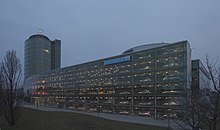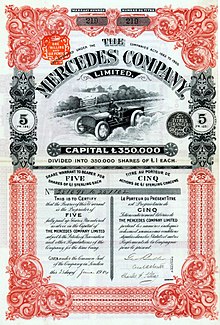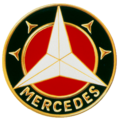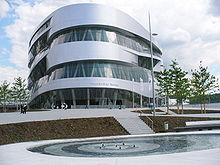Mercedes Benz
| Mercedes Benz | |
|---|---|

|
|
| Owner / user | Daimler AG |
| Introductory year | 1926 |
| Products | Automobiles |
| Markets | Worldwide |
| Website | mercedes-benz.de |
Mercedes-Benz is a registered trademark for automobiles of Daimler AG . The name was created in 1926 after the merger of Daimler-Motoren-Gesellschaft ( Mercedes brand ) with Benz & Cie. to Daimler-Benz AG . In 2016, 2.08 million new vehicles of the brand were sold.
Definition of terms
As the Daimler-Benz group diversified, the core business was transferred to Mercedes-Benz AG on June 29, 1989 , which took over the development and production of passenger cars and commercial vehicles. After the end of the "Integrated Technology Group", the passenger car and commercial vehicle business were separated from one another on April 1, 1997 and divided into different business areas.
The Mercedes-Benz brand is to be distinguished from the Mercedes-Benz Cars (MBC) division, which not only carries the Mercedes-Benz car brand but also the Smart brand . On January 1, 2019, it was spun off together with the Mercedes-Benz Vans division into the newly founded Mercedes-Benz AG , a wholly-owned subsidiary of Daimler AG. The utility vehicles of the brand Mercedes-Benz include not only the division Mercedes-Benz Vans also for Daimler Trucks & Buses, in which also on Nov. 1, 2019 Daimler Truck AG was spun off.
The name “Daimler” is sometimes used colloquially for a Mercedes-Benz. Although Daimler AG is contractually permitted to use the brand name for products, there is currently no Daimler AG vehicle with this name. For the history of naming rights, see Daimler Motor Company # naming rights .
Mercedes-Benz vehicles
Almost all types of motor vehicles are sold under the Mercedes-Benz brand :
| Vehicle type | Division of Daimler AG | items |
|---|---|---|
| Car | Mercedes-Benz Cars | Mercedes-Benz cars |
| Vans | Mercedes-Benz Vans | |
| Transporter | Mercedes-Benz vans | |
| truck | Daimler Trucks | Mercedes-Benz truck |
| commercial vehicles | Mercedes-Benz Unimog | |
| buses | Daimler Buses | Mercedes-Benz bus |
Furthermore, the following vehicles based on the above-mentioned model groups are offered under the Mercedes-Benz brand, some of which are also manufactured by external companies:
| Vehicle type | general article |
|---|---|
| Recreational vehicles and motorhomes | Motorhome |
| Special vehicles |
Emergency vehicles special protection vehicles taxis ambulances ambulances special commercial vehicles |
In addition, until 1991 , tractors were produced under the name MB-Trac .
Daimler AG produces with a high degree of vertical integration , as it z. B. Steering and manual and automatic gearboxes developed and manufactured in-house. In engine construction there are a large number of series that are used in the various model groups. It is not uncommon for the same engine to be used in cars , off-road vehicles and vans, see the list of engines from Mercedes-Benz .
history
Sales of Mercedes automobiles since 1901
The Daimler-Motoren-Gesellschaft (DMG) founded in 1890 did not originally sell its vehicles under the Mercedes name. The brand did not emerge until the turn of the century, inspired by the businessman Emil Jellinek , who traded in Daimler vehicles from 1898. From 1899 Jellinek took part in the Nice race week under the pseudonym Mercedes (based on the name of his daughter Mercédès Jellinek ). Although "Mercedes" was only used as a driver's name at that time and not yet as an automobile designation, the name became known in connection with DMG. In 1900 Jellinek agreed to manufacture the new, high-performance "Daimler-Mercedes" engine, which was the first time the name Mercedes was used as a product name. At the same time he became a sales partner for Daimler cars and engines and ordered 36 vehicles for a total price of 550,001 marks (according to today's value about 3.82 million euros ), as well as a few weeks later a further 36 Daimler cars with 8 hp engines.
After several of these Mercedes vehicles (the name was now also used for the cars) drove successfully at the Nice Race Week in 1901, the level of awareness of Mercedes grew enormously; in September 1902 the name "Mercedes" was legally protected for DMG. The Mercedes star was registered as a trademark in 1909 and has also been used as a radiator symbol since 1910, without a surrounding ring in the first few years.
Merger to form Daimler-Benz AG
Daimler-Motoren-Gesellschaft merged in 1926 under the leadership of Deutsche Bank with competitor Benz & Cie. , whose motor car drove under the name "Benz" as early as 1886, and formed Daimler-Benz AG . This resulted in the new brand name Mercedes-Benz , which was protected in the same year with the Mercedes star logo .
In the 1930s, the legendary Silver Arrows shaped the brand image in competition with Auto Union . Mercedes-Benz manufactured upper and luxury class models in the passenger car sector and was able to take a leading position here. In the post-war years, the production of cars was only resumed in 1947. The previous numbers were quickly reached again. The products were also successful worldwide thanks to further production facilities abroad. The US market, which had become Mercedes-Benz's largest foreign market since the early 1960s, was of particular importance. It was not until the end of the 1980s that Mercedes-Benz faced serious competition in Europe with BMW and later with Audi, as well as with Lexus on the US market . Despite this, Mercedes-Benz has successfully maintained its position on the world market and recorded record sales in 2012 and 2013 (with 1,461,680 automobiles sold). Aero engines were also produced at times under the brand name Mercedes-Benz.
New registrations of Mercedes-Benz cars in the German Reich from 1933 to 1938
| year | Registration numbers |
|---|---|
| 1933 | 7,844 |
| 1934 | 8,873 |
| 1935 | 11,529 |
| 1936 | 19,816 |
| 1937 | 23,679 |
| 1938 | 20,889 |
Development of the logo
Motorsport
Mercedes-Benz has been involved in motorsport for a long time, including Formula 1 . In the 1930s, Mercedes achieved great success with the “ Silver Arrows ” under Alfred Neubauer . After the war, Juan Manuel Fangio won the Formula 1 World Championship in a Mercedes-Benz W 196 in 1954 and 1955 .
1955 ended Daimler-Benz's commitment in motorsport first after the 24-hour race at Le Mans for today severe accidents (84 deaths) occurred in the motor racing history. It wasn't until 1988 that the company returned to racing at the factory. In Formula 1, Mercedes-Benz and McLaren formed the McLaren-Mercedes team from 1995 . The engines were manufactured by Ilmor or the Mercedes subsidiary Mercedes-Benz HighPerformanceEngines . In 1998 and 1999 Mika Häkkinen and 2008 Lewis Hamilton became Formula 1 world champions in a McLaren-Mercedes.
On November 16, 2009, Daimler AG announced that it would take over 75.1% of the team shares in Brawn GP , which competed for the first time in the same year and had won the Drivers 'and Constructors' World Championship with Mercedes engines. Since then, the racing team has competed under the name Mercedes Grand Prix (until 2011) and Mercedes AMG F1 Team (since the 2012 season) as a Mercedes works team under the German flag. The official seat of the team is the Daimler headquarters in Stuttgart. The team operated like its predecessor Brawn GP from Brackley, England. In the course of acquiring Brawn GP, Mercedes-Benz ended its exclusive partnership with the British McLaren Group and sold its 40 percent stake in it.
From 2014 to 2019, the team won both the constructors 'and drivers' championships six times in a row ( Lewis Hamilton in 2014, 2015 and 2017-2019 and Nico Rosberg in 2016).
Mercedes Benz Museum
The Mercedes-Benz Museum in Stuttgart-Untertürkheim shows historic vehicles from the Mercedes-Benz brand, from the first automobile with a combustion engine to the Silver Arrows to the present day. Since 2006 it has been housed in a new, modern building. Together with the Mercedes-Benz branch in Stuttgart, the museum forms the Mercedes-Benz world .
Others
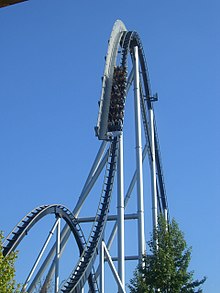
- Wilhelm Friedle , operations director of Daimler-Benz AG at the Sindelfingen plant from 1927 to 1935, introduced assembly line production at Mercedes .
- From 1931 Adolf Hitler let himself be driven in the Type 770 , of which he received two copies at a special price. The second type 770 (registration number IIA 19357) was offset against the advertising costs in the NSDAP party organ Völkischer Beobachter .
- The singer Janis Joplin and the poet and dramaturge Michael McClure wrote a song titled Mercedes Benz in 1970 .
- Was 2002 Silver Star in Europa-Park opened in Rust: a roller coaster, the "Mercedes-Benz" as a sponsor for the topic has.
- Mercedes-Benz Veterans Club of Germany
- Since February 2007 you can virtually test drive the Mercedes C-Class in the 3D world Second Life .
- In Bad Aussee (Austria) there is a pedestrian bridge in the shape of a Mercedes star .
Sponsorship
Sports teams
- Mercedes-Benz has been a partner since 1972 and the general sponsor of the German Football Association since 1990, as well as being the main sponsor of the German national football team .
- Mercedes-Benz has been the exclusive partner of the Bundesliga soccer club VfB Stuttgart since 2007 .
Sports facilities
Several sports and event venues bear the name of the brand. Two of them are operated by the Anschutz Entertainment Group (AEG).
- On July 30, 2008, the Gottlieb Daimler Stadium in Stuttgart's Neckarpark , to which Daimler AG has held the naming rights since 1993, was renamed the Mercedes-Benz Arena .
- The Shanghai World Expo Cultural Center in Shanghai , China , which was completed in 2010, has also been called the Mercedes-Benz Arena since 2011 .
- In October 2011 it was announced that the Louisiana Superdome in New Orleans , USA , which was built in 1975 and renovated in 2005 after Hurricane Katrina , will bear the name Mercedes-Benz Superdome until 2021 .
- In 2015, the former O2 World Berlin operated by AEG was renamed the Mercedes-Benz-Arena .
- The newly built stadium in Atlanta , USA, which opened on August 26, 2017, bears the name Mercedes-Benz Stadium .
Sporting events
- At the ATP tournament in Stuttgart , Mercedes-Benz has been the name sponsor since 1979, which has been called the MercedesCup since then .
- Mercedes-Benz has been the name sponsor of the Mercedes-Benz Junior Cup since 1991 .
Promotional ambassadors
- Franz Beckenbauer has been promoting Mercedes-Benz as a testimonial since 2010 .
- In 2012 it became known that Mercedes-Benz had signed testimonial contracts with the two national players Mario Götze and Benedikt Höwedes .
- National coach Joachim Löw and team manager Oliver Bierhoff of the German national soccer team also had testimonial contracts with Mercedes-Benz.
- In 2013, Willem Dafoe , Usher and Kate Upton , among others, advertised Mercedes-Benz.
literature
- Jürgen Schlegelmilch: Mercedes-Benz: Your good star on all roads. Four decades of Mercedes-Benz advertising . Heel, Königswinter 2007, ISBN 978-3-89880-709-8 .
- Arnd Zschiesche : A positive prejudice against Germany - Mercedes-Benz as a design system . LIT-Verlag, Berlin 2007, ISBN 978-3-8258-0904-1 .
- For further literature see also article Daimler-Benz and Daimler AG
- Car tests by Mercedes-Benz in auto motor und sport
Web links
- German company website (uses Java and Flash)
- Mercedes-Benz Cloud Computing Connected Cars (English)
- Tests at auto motor und sport
Individual evidence
- ↑ Information on the Mercedes-Benz brand in the register of the German Patent and Trademark Office (DPMA)
- ↑ FAZ.net January 9, 2017: Mercedes-Benz sells more than two million cars for the first time
- ↑ Mercedes-Benz AG founded. Daimler AG, accessed on November 28, 2019 .
- ^ Daimler-Benz AG: New organizational structure. Daimler AG, accessed on November 28, 2019 .
- ↑ The “Daimler” brand before the revival? Tata thinks about Rolls-Royce competition. Handelsblatt.com, July 28, 2008, accessed October 25, 2019 .
- ↑ mercedes-benz-publicarchive.com
- ↑ daimler.com
- ^ From the interest group to Daimler-Benz AG. Retrieved October 17, 2019 .
- ↑ Information on the brand Mercedes Benz word / figurative mark in the register of the German Patent and Trademark Office (DPMA)
- ↑ Mercedes-Benz on record course message from Daimler Investor Relations, January 20, 2014 (PDF).
- ↑ First powered flight in history with a Daimler single-cylinder engine 125 years ago. Daimler AG, August 7, 2013, accessed on January 31, 2020 .
- ^ Hans Christoph von Seherr-Thoss : The German automobile industry. Documentation from 1886 until today . Deutsche Verlags-Anstalt, Stuttgart 1974, ISBN 3-421-02284-4 , p. 328 .
- ↑ The true story behind the Mercedes-Benz three-pointed star
- ↑ Michael Behrndt, Jörg Thomas Födisch, Ulrich Kudrass: Formula 1 world champion since 1950 . Ed .: HEEL Verlag GmbH. 2010, ISBN 978-3-86852-304-1 .
- ↑ Michael Behrndt, Jörg T. Födisch, Ulrich Kudrass: Formula 1 world champion since 1950 . Ed .: HEEL.
- ↑ Henning Hinze How the car brought Hitler to power , in Autobild No. 2/2014, p. 41.
- ↑ Advertising & Selling: DFB general sponsor: VW replaces Mercedes - W&V. Retrieved March 15, 2019 .
- ↑ Mercedes-Benz becomes the exclusive partner of VfB Stuttgart. Retrieved March 15, 2019 .
- ↑ New name: Gottlieb Daimler Stadium. Retrieved March 15, 2019 .
- ↑ Gottlieb Daimler Stadium renamed the "Mercedes-Benz Arena". Retrieved March 15, 2019 .
- ↑ Chinese arena extends naming right deal. Retrieved March 15, 2019 .
- ↑ Stuttgarter Nachrichten, Stuttgart Germany: Naming rights: Football now in the Mercedes-Benz Superdome. Retrieved March 15, 2019 .
- ↑ Mercedes-Benz Arena Berlin: Mercedes-Benz and the Anschutz Entertainment Group expand their partnership. mercedes-benz-arena-berlin.de, January 21, 2015, accessed on October 20, 2015 .
- ↑ Roof and video wall cause problems . In: Stadium World . ( stadionwelt.de [accessed on February 24, 2018]).
- ↑ Philipp Deppe: The ATP tournament in Stuttgart will also be called the MercedesCup for the next three years. December 3, 2009, accessed April 19, 2012 .
- ↑ Daimler AG (Ed.): German teams dominate the 22nd Mercedes-Benz Junior Cup. 2012, accessed April 19, 2012 .
- ↑ After DFB-Elf and Schumi: Mercedes gets Franz Beckenbauer as a testimonial. Retrieved March 15, 2019 .
- ↑ Young footballers for compact cars: Mercedes-Benz changes Mario Götze and Benedikt Höwedes. Retrieved March 15, 2019 .
- ↑ Advertise & Sell: Mercedes-Benz will remain DFB sponsor until 2018 | W&V. Retrieved March 15, 2019 .
- ↑ Scooped - Mercedes Benz 2013 commercial featuring Willem Dafoe, Kate Upton and Usher. (No longer available online.) In: superbowl-commercials.org. Archived from the original on February 20, 2014 ; accessed on March 13, 2014 (English).
| Vehicle class | 1920s | 1930s | 1940s | ||||||||||||||||
| 6th | 7th | 8th | 9 | 0 | 1 | 2 | 3 | 4th | 5 | 6th | 7th | 8th | 9 | 0 | 1 | 2 | 3 | 4th | |
| Compact class | W 15 (type 170) | ||||||||||||||||||
| W 23 (type 130) | |||||||||||||||||||
| W 30 (type 150) | |||||||||||||||||||
| W 28 (type 170 H) | |||||||||||||||||||
| Middle class | W 02 (type Stuttgart 200) | W 136 / W 149 (types 170 V / 200 V) | |||||||||||||||||
| W 11 (type Stuttgart 260) | W 143 (type 230 n) | ||||||||||||||||||
| W 21 (type 200/230) | W 153 (type 230) | ||||||||||||||||||
| W 138 (type 260 D) | |||||||||||||||||||
| upper middle class | W 03 / W 04 / W 05 (types 300/320/350) | W 18 (type 290) | |||||||||||||||||
| W 10 / W 19 (types 350/370/380) | W 142 (type 320) | ||||||||||||||||||
| W 22 | |||||||||||||||||||
| Upper class | Type 400 & Type 630 | W 24 / W 29 / W 129 (types 500 K / 540 K / 580 K) | |||||||||||||||||
| W 08 (type Nürburg 460/460 K / 500 / type 500 N) | |||||||||||||||||||
| W 07 / W 150 (types 770/770 K) | |||||||||||||||||||
| Sports car | Model K | ||||||||||||||||||
| W 06 (type S / SS / SSK / SSKL) | W 24 / W 29 / W 129 | ||||||||||||||||||
| Off-road vehicle | W 103 (type G1) | W 31 (type G4) | |||||||||||||||||
| W 133 III (type 170 VG) / W 139 (type 170 VL) / W 152 (type G5) | |||||||||||||||||||
| Vans | L 3/4 | L 1000 Express | L 301 | ||||||||||||||||
| L 300 | |||||||||||||||||||
